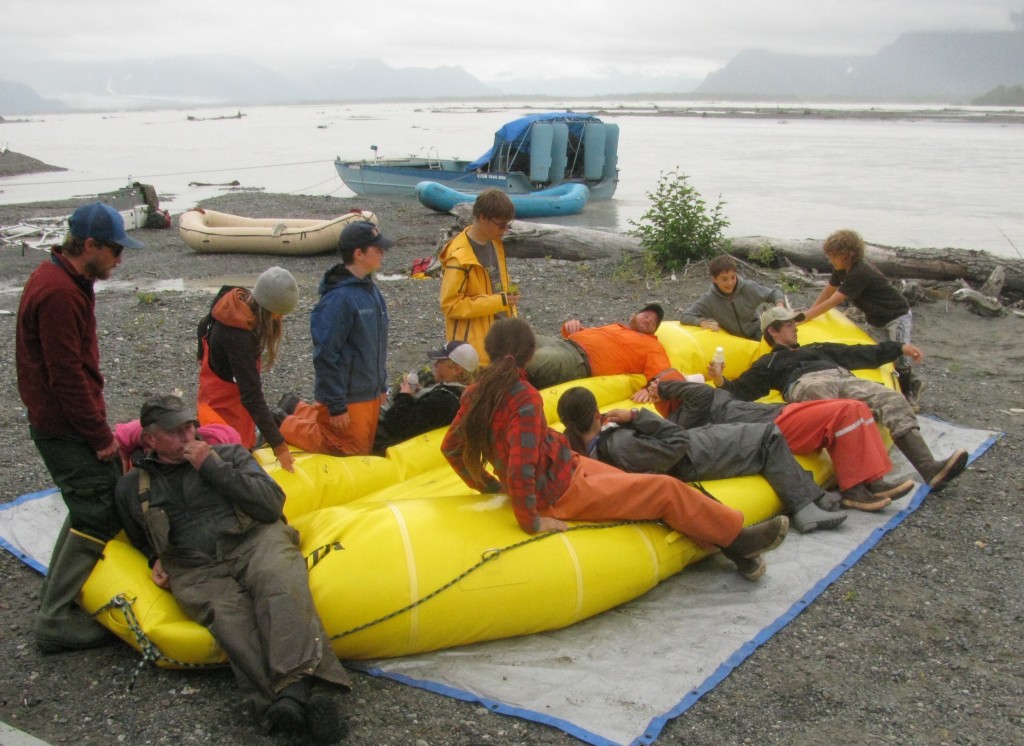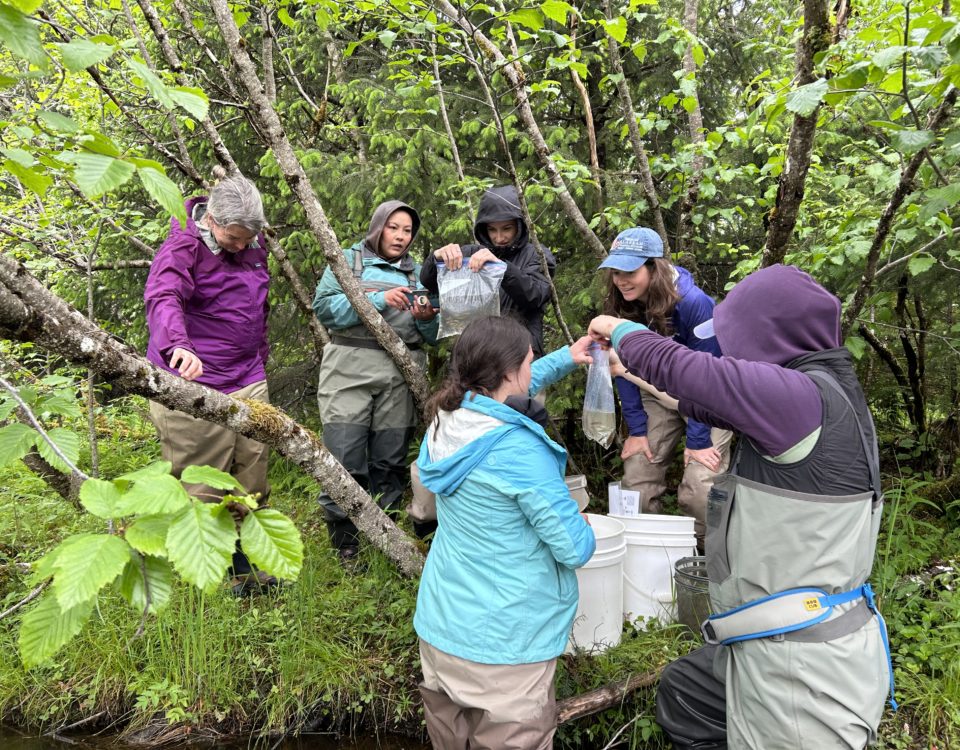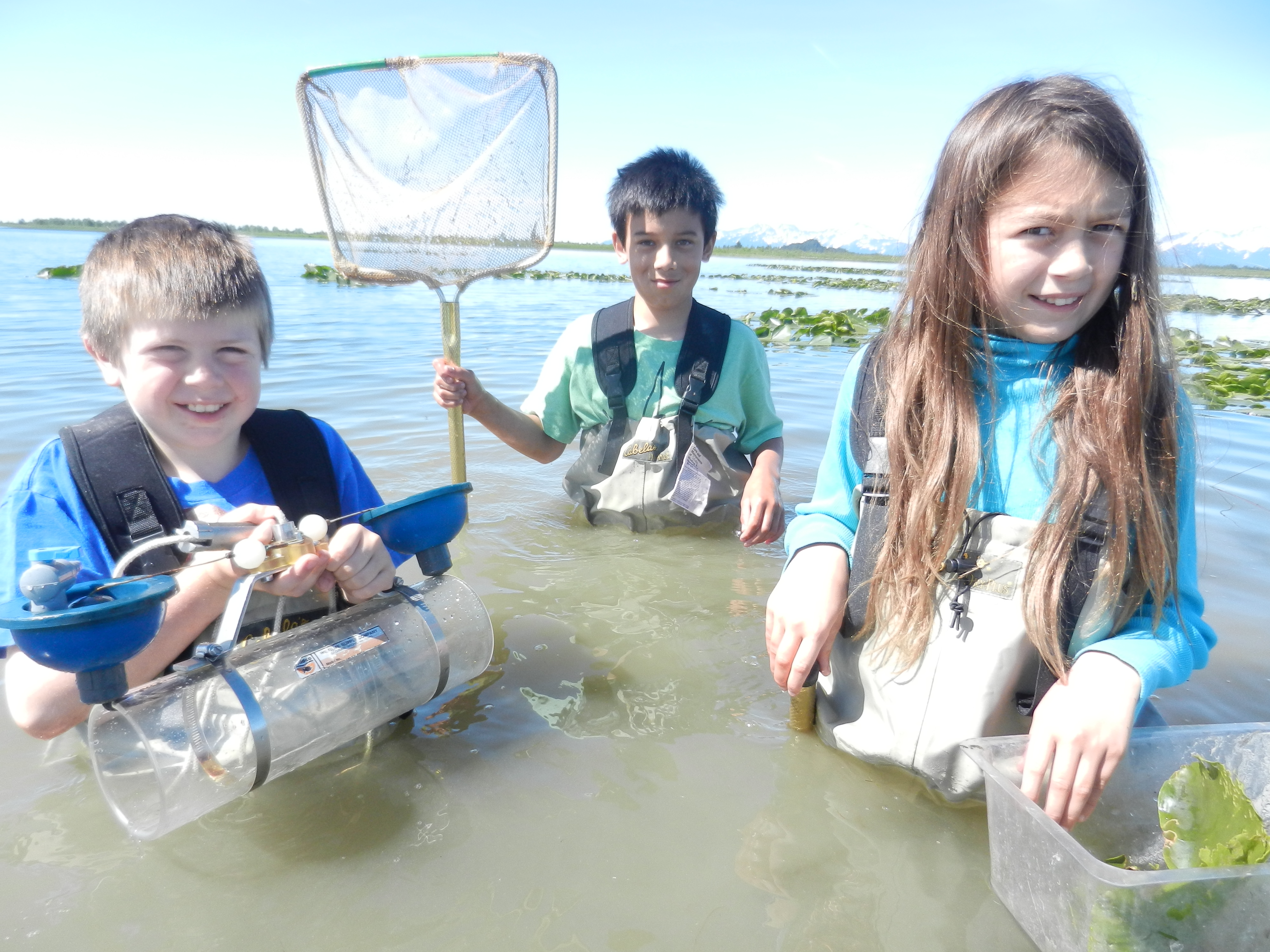Students Become Stewards of Copper River Watershed

An epic journey ended on the banks of the Copper River earlier this month. Thirteen high school students and ten adults completed a ten-day adventure from the northern reaches of the Copper River watershed down to the mouth of the river, near Cordova.
The Copper River Watershed Project orchestrates this once-in-a-lifetime opportunity through the Copper River Stewardship Program, and this year, two Prince William Sound Science Center staff joined the adventure. Science Education Coordinator, Lauren Bien, helped guide the education component through the trip’s entirety, while Education Specialist, Meadow Scott, led students on a plant-focused rain forest hike once they finally reached Cordova.

Students, educators, and rowers pose in front of an escaped fish wheel along the banks of the Copper River. Back Row: Elias Hanson, Arctic Buchanan, John Appleton, Ria Smyke, Anika Witsoe, Nikki Friendshuh, Alexis Hutchinson; Front Row: Scott Hickox, Flynn Milligan, Eric Lutz, Glenn Hart, Akilena Veach, Helen Laird, Lauren Bien, Zoe Russin, Barry Whitehill, Kate Morse, Faith Collins, Thomas Abraham, Carolyn Venner, Luke Wassink, Ryan Chalker, Tim Skiba
Photo credit: Flynn Milligan
Seven Cordova high school students joined forces with six students from various upriver communities, including Kenny Lake, Glennallen, Slana and Gakona. From traveling through the northern boreal forests to lush temperate rainforests, students gained insight into the stark contrasts between the upriver and downriver ecosystems. One ninth-grader from Slana, Thomas Abraham, was thrilled to see bears, Dolly Varden, and huge trees for the first time. Cordova ninth-grader, Elias Hanson also noted that he never realized how challenging fishing methods were in the turbid waters upriver. Executive Director of the Watershed Project, Kristen Carpenter, explains that this trip gives students a chance to explore “their bigger backyard, because we all depend on the entire resource.”
Because Cordova is not connected by a man-made road system, the linkages across watershed communities are sometimes overlooked. For example, when sharing how he previously viewed the watershed, Hanson noted, “when I was little, I used to think Miles Lake was the end.” This program, however, encourages students to think about the watershed as a whole. Abraham, reflected on this aspect by saying “we’re kind of on a balance; if something is off on one side, it can impact both sides of the scale.” These realizations are crucial for sustainable resource management, which is ultimately the aim

Students identify a Dolly Varden trout, caught using a minnow trap in an unnamed stream north of Baird Canyon. Photo credit: Lauren Bien
of this program. Copper River Watershed Project Program Director, Kate Morse, explains this goal in that “these are the future stewards of the watershed. The more they understand the importance of an intact, healthy ecosystem and the diversity of uses and lifestyles supported by salmon, the better decisions they might be inclined to make.”
Before setting off on the 91-mile rafting trip from Chitina to Cordova, students toured the Gulkana Hatchery, were introduced to the Alyeska Pipeline, and learned about fish wheels and other subsistence fishing techniques. After setting off on their six-day rafting adventure, Morse describes how the students were amazed at the terrain changes—shifting away from places like Kenny Lake, which receives 9-10 inches of rain per year to Cordova, where similar rainfall can occur in a single day in September. Students conducted three plant surveys along their route, starting in the boreal forest, then on the banks of the Copper and finally in the temperate rainforest at the mouth of the river. They also got their feet wet in a citizen science project called ‘Salmon Blitz,’ in which participants document salmon habitat along the Copper River watershed, with the goal of informing future resource management decisions. Upon reaching Cordova, the US Forest Service introduced students to Dusky Canada Goose nesting grounds on the Delta and the Alaska Department of Fish and Game showed students how and why they dissect fish ear bones, or otoliths, to learn more about their life histories.
To organize such a massive undertaking, Morse emphasized that “it takes a watershed to raise good watershed stewards,” and that “there is a myriad of partners that make this program happen.” Kate Morse of the Copper River Watershed Project and Robin Mayo of the Wrangell Institute for Science and Environment were key educators on this trip, as well as Lauren Bien of the Prince William Sound Science Center and Glen Hart of

Students deflate rafts after traveling 91 miles down the Copper River as part of the Copper River Stewardship Program. Photo credit: Meadow Scott
Wrangell St. Elias National Park and Preserve. Additional Stewardship partners include
the Bureau of Land Management and the US Forest Service. Morse also sends a big thank you to parents for facilitating their child’s participation and encourages the Cordova community to continue setting a good example for our youth by acting as good stewards of the Copper River watershed.
This article is modified from one originally published in the July 15, 2016 edition of The Cordova Times




